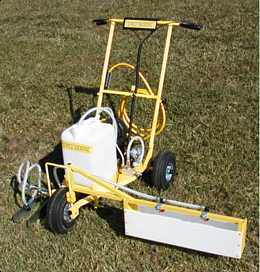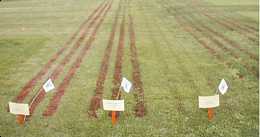Field Paint Tests
NEWS RELEASE, Norfolk, NE - 7/21/02
IOWA FIELD DAY -- E-100 DEMONSTRATION AND TEST PLOTS, PAINT BOOM DEMO, PAINT STRIPPING, GROWTH INHIBITOR, AND STENCIL PLOTS
 The Tru Mark Athletic Field Marker Model E-100 with optional Paint Boom was demonstrated at the annual 2002 Iowa Turfgrass Field Day, July 18, 2002. The Paint Boom, a two nozzle sprayer in a fixed 24" paint box, is a cost effective method of applying hash marks, block letter and lining. Dale Roe, ISU Athletic Field Maintenance Supervisor stated, "the E-100 Paint Boom design provides a easy and quick method of lining hash marks and block lettering."
The Tru Mark Athletic Field Marker Model E-100 with optional Paint Boom was demonstrated at the annual 2002 Iowa Turfgrass Field Day, July 18, 2002. The Paint Boom, a two nozzle sprayer in a fixed 24" paint box, is a cost effective method of applying hash marks, block letter and lining. Dale Roe, ISU Athletic Field Maintenance Supervisor stated, "the E-100 Paint Boom design provides a easy and quick method of lining hash marks and block lettering."
The Iowa State University personnel established a test plot of different athletic field marking paints. The most striking test plot was a comparison of two growth inhibitors and a control set of field marking lines. In addition, a ISU football Big 12 stencil application was presented.
Field Marking Paint Comparison
A picture highlights basically three categories of athletic field paints. The field marking paints were applied 4 days before event, using a 1 to 1 ratio of water to paint. Dale Roe applied these different paints using a one nozzle field marker. The photo shows that the World Class and Mautz field paints as the most distinctive while Fastliner and Pioneer field paints were in the second category.
Growth Inhibitor Comparison
The test plot shows a noticeable difference between the use of a growth inhibitor applied as part of the field lining activity. The three set of lines on the left is with a 1 oz. Primo application to 1 gallon of diluted field paint. The next set of three lines is with a 1/2 oz. of Primo and the center set of three lines is the control group without an y growth inhibitor. The far right set of three lines is applied using 1 oz. Embark and the next set of three from the left is with 1/2 oz. of Embark to 1 gallon of diluted paint.
y growth inhibitor. The far right set of three lines is applied using 1 oz. Embark and the next set of three from the left is with 1/2 oz. of Embark to 1 gallon of diluted paint.
The test plot was painted on June 28th, three weeks before the field day. It shows that with a growth inhibitor you can reduce the number of times you line strip for field areas without a lot of wear, e.g., soccer, band, and baseball.
Dale Roe stated that they typically apply Primo at a 1 oz. rate three times a season to reduce the number of stripping applications while maintaining quality looking lines on their practice fields.
Stencil Demonstration
Dr. Dave Minner explained the ISU stencil procedures for football field applications. The whole area of the stencil is painted a week before the event with Primo. The outline of the stencil is made aerosol cans. Then the initial stencil is painted using a 3 to 1 ratio of water to paint. A second pass with a lower dilution factor is applied with Primo normally the day before the game.
For end zone stripping they cut the end zones 1/4" to 1/3" shorter than the rest of the field on Tuesday or Wednesday, then paint using Primo, and then again mow the morning of game day. Cutting the grass shorter earlier in the week along with using the growth inhibitor doesn't cause the paint markings to be mowed off later in the week.